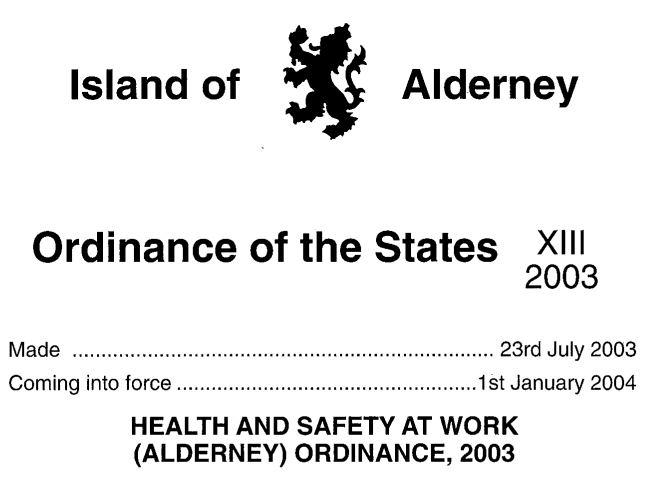We’ve all heard the saying that there are no health and safety laws in Alderney, this is a widespread misconception. In reality, Alderney has two health and safety regulations designed to protect workers and the public. These are the Health and Safety at Work (Alderney) Law 1997 and the Health and Safety at Work (Alderney) Ordinance 2003.
In this post, I’ll aim to debunk the myths and shed light on the actual state of health and safety laws in Alderney, and what they mean for island workplaces.
The Health and Safety at Work (Alderney) Law, 1997
The Health and Safety at Work (Alderney) Law 1997 establishes a legal framework for ensuring the health, safety, and welfare of people at work in Alderney. It allows the States of Alderney to make ordinances for a range of health and safety matters, including securing the health, safety, and welfare of workers; protecting the public from health and safety risks associated with work activities and regulating dangerous substances, amongst various other things. The law also outlines the administration of legislation, offences, and penalties.
In more simplistic terms, The Health and Safety at Work (Alderney) Law, 1997 doesn’t really do much other than allow the States of Alderney to make further Ordinances below it, which is what they did in 2003…

Health and Safety at Work (Alderney) Ordinance, 2003
Six years after initially drafting the law. The States of Alderney passed the Health and Safety at Work (Alderney) Ordinance, 2003. This ordinance is very similar to Guernsey’s Health and Safety at Work (General) (Guernsey) Ordinance, 1987, and the UK’s Health and Safety at Work Act, 1974.

The Health and Safety at Work (Alderney) Ordinance 2003 is a much more comprehensive legal document that outlines the general duties and responsibilities for ensuring health and safety at work in Alderney. Here’s a quick summary of each section:
PART I: GENERAL DUTIES OF EMPLOYERS, EMPLOYEES, AND OTHERS
- General duties of employers to their employees: Emphasises employers’ responsibility to ensure employee health, safety, and welfare.
- Duties of employers and self-employed to persons other than their employees: Focuses on the broader responsibility to the public and other non-employees.
- Duties concerning premises to non-employees: Addresses the safety and health obligations of those controlling non-domestic premises.
- Duty regarding harmful emissions: Targets the control of harmful emissions to protect the environment.
- Duties of manufacturers regarding work safety: Covers the responsibility of manufacturers to ensure the safety of substances used at work.
- General duties of employees at work: Highlights employees’ responsibility for their own and others’ safety.
- Duty not to misuse provided safety equipment: Prohibits the misuse of safety equipment or materials.
- Prohibition on charging employees for safety measures: Ensures that employees are not charged for safety provisions.
- Notification and reporting of injuries and dangerous occurrences: Requires reporting of workplace injuries, diseases, and dangerous events.
- Records: Mandates keeping detailed records of reportable incidents.
- Restrictions on the application of section 9: Clarifies limitations on reporting requirements.
- Power of the Committee to direct investigations: Grants the Committee authority to direct safety investigations. (The Committee being the Policy and Finance Committee)
PART II: APPROVED CODES OF PRACTICE
- Approval of codes of practice: Details the process for the Committee to approve and issue codes of practice.
- Use of approved codes in criminal proceedings: Explains how approved codes can be used as evidence in legal actions.
PART III: ENFORCEMENT
15-24. Covers the appointment and powers of inspectors, enforcement notices, appeals, and information handling: These sections detail the enforcement framework, including inspector powers, issuance of improvement and prohibition notices, appeal processes, and confidentiality of information.
PART IV: PROVISIONS AS TO OFFENCES
25-29. Outlines the offences, liability of other persons and corporate bodies, burden of proof, and court powers to order remedies: This part specifies various offences, assigns liability, and details the legal processes for addressing non-compliance.
PART V: MISCELLANEOUS AND GENERAL
30-37. Covers appeals, notice service, civil liability, and the ordinance’s application to domestic employment: The final part addresses miscellaneous provisions including appeal rights, how notices are served, civil liabilities arising from breaches, exclusions for domestic employment, and general interpretations within the ordinance.

How Alderney’s Health and Safety Regulations Compare with Guernsey and the UK
In the UK, the Health and Safety at Work Act 1974 lays down the overarching framework for managing workplace health and safety. This primary piece of legislation is supported by an array of different regulations targeting specific aspects of workplace safety, such as the Control of Substances Hazardous to Health Regulations 2002 (COSHH), the Lifting Operations and Lifting Equipment Regulations 1998 (LOLER) and the Management of Health and Safety at Work Regulations 1999. When combined, these regulations along with Approved Codes of Practice (ACoPs) and other guidance give clear directions to employers and employees on their responsibilities and best practices for ensuring a safe working environment.
Guernsey’s approach is similar in some respects to the UK but it also shares some similarities with Alderney. Guernsey, like Alderney, has a Health and Safety Law that allows for the drafting of ordinance’s. The main piece of legislation is the Health and Safety at Work etc. (Guernsey) Law, 1979, and the major ordinance is the Health and Safety at Work (General)
(Guernsey) Ordinance, 1987.
More like the UK, Guernsey also has other regulations, ordinances and approved codes of practise that sit below the main law to help govern health and safety at a more detailed level (though these are by no means as far reaching as the UK). They include legislation like The Health and Safety at Work (Equality Provisions) Ordinance, 2021; The Health and Safety at Work (Dangerous Substances) (Guernsey) Regulations, 2021; and the Guernsey Construction (Design and Management) 2020 Approved Code of Practice.
Alderney, has seemingly taken a less thorough approach to the finer details of regulation than the other two jurisdictions. It has the The Health and Safety at Work (Alderney) Law, 1997; and the Health and Safety at Work (Alderney) Ordinance, 2003.
The ordinance, whilst fairly vague on describing exactly what businesses, employers and employees must do to protect health and safety, it does lay enough of the ground work to ensure things are done correctly, safely and in line with other jurisdictions. In the next section I’ll explain exactly how this is achieved and what it means on the island…
What Health and Safety Laws Mean For Alderney Businesses

The Health and Safety at Work (Alderney) Ordinance, 2003 is just a slightly shorter version of the UK’s Health and Safety at Work Act 1974, the first few paragraphs on employer duties are word for word identical. Both of these pieces of legislation set out a framework for what duties fall on employers and employees to protect health and safety.
You can think of them as the “what needs to be done” of health and safety. The UK goes a step further by providing regulations, Approved Codes of Practice (ACoPs), and guidelines that detail “how to do it.” Alderney, on the other hand, keeps it more straightforward without diving into the details.
This is where things become a little more difficult to follow, but crucial for understanding how Alderney’s approach to health and safety regulation is implemented.
Section 15 of the Health and Safety at Work (Alderney) Ordinance, 2003 refers to the Appointment of inspectors. It states;
“1) The Committee may appoint as inspectors (under whatever title it may from time to time determine) such persons having suitable qualifications as it thinks necessary for carrying into effect the relevant statutory provisions, and may terminate any appointment made under this section.
(2) Every appointment of a person as an inspector under this section shall be made by an instrument in writing, and the inspector shall, if so required when exercising or seeking to exercise any power conferred on him by any of the relevant statutory provisions, produce his instrument of appointment or a duly authenticated copy thereof.
(3) Without prejudice to the generality of the foregoing, a person appointed as an inspector under this section may be
a person employed in the Guernsey public service.”
Essentially what this means is that the States of Alderney Policy and Finance Committee may appoint a health and safety inspector, and that health and safety inspector may be a member of the Guernsey civil service, i.e. the Guernsey Health and Safety Executive (HSE). This is exactly what has happened, the Guernsey HSE is the health and safety regulator for both Guernsey and Alderney.
Guernsey HSE state:
“HSE in Guernsey deem that, where Guernsey legislation is silent as to a topic, the UK regulations, ACoP and guidance provide the appropriate standard to be achieved.”
The reference to UK regulations, Approved Codes of Practice (ACoPs), and guidance as a benchmark in the absence of specific local legislation in Alderney or Guernsey acts as a form of soft precedent. This does not mean that UK law directly applies in Alderney, but that the standards and practices established in the UK serve as a model for what is considered best practice.
What this means for Alderney businesses is that Alderney is essentially subject to Guernsey and UK Health and Safety regulations, ordinances, ACoPs and guidance. These are the tried and tested methods of health and safety management and are taken as the benchmark needed to fulfil the duties under the Health and Safety at Work (Alderney) Ordinance, 2003. If a business was taken to court for a breach of health and safety laws, they would be prosecuted under the Alderney Law and Ordinance, whilst taking Guernsey and UK guidance and legislation as best practice for the standard that was required and should have been provided.
Ultimately, in order to stay compliant, and protect their employees and the public to the best of their ability, businesses in Alderney need to fully comply with the UK’s health and safety legislation.
This may sound a bit daunting, but it doesn’t have to be. If you need a hand keeping your employees safe and getting your business in Alderney to the required level of health and safety compliance, get in touch with us today and see how we can help!


Pingback: Understanding the Health and Safety at Work (Alderney) Ordinance, 2003 – acisafety.co.uk